Learn how dubbing a video can expand your audience. Our guide covers script adaptation, AI tools, recording, and pro-level audio mixing for amazing results.
In This Article
Subscribe to our newsletter
So, what exactly is dubbing? In simple terms, it's the art of replacing the original dialogue in a video with a new, translated version. But it’s so much more than that. The real goal is to create an experience so seamless and natural that the content feels like it was originally made in the viewer's native language.
It's about creating a truly immersive experience that simple subtitles just can't match.
Why Dubbing Unlocks Global Audiences
Moving beyond subtitles is how you build a real, immediate connection with viewers across the globe. When you start dubbing a video, you're not just swapping out words; you're adapting an entire experience.
This isn't just a small tweak—it's a strategic move that builds trust and seriously boosts engagement. You're removing the cognitive load of reading, which allows your audience to sit back and fully absorb what's happening on screen.
Think about the psychological impact for a second. Hearing something in your own language feels personal, direct, and just… easier. An e-learning platform, for example, might see its course completion rates skyrocket after adding dubbed versions because students can finally focus on learning instead of translating.
We see this with YouTube creators all the time. They can break into entirely new markets, sometimes even tripling their international viewership, just by offering localized audio tracks. It really is about meeting your audience where they are, in a language they understand without a second thought.
The Makings of a Great Dub
A top-notch dubbing project needs more than just a good microphone and a translated script. It's a craft, a multi-layered process where every detail counts.
Here’s what really makes a dub stand out:
- Smart Script Adaptation: This is non-negotiable. A literal, word-for-word translation almost always sounds clunky and unnatural. It completely misses the cultural nuances, idioms, and humor that make dialogue feel authentic. Good adaptation makes the script sound like it was written by a native speaker.
- The Right Voice: The voice you choose has to match the original actor's tone, age, and emotional delivery. Whether you’re working with a human voice actor or a sophisticated AI voice, the performance has to be believable.
- Spot-On Lip-Sync: The new audio has to line up with the speaker's lip movements on screen. This used to be incredibly difficult, but modern tools—especially AI platforms—have made achieving precise synchronization much more manageable.
- Professional Audio Mixing: This is the final polish. It involves blending the new dialogue track with the original music and sound effects (often called the M&E track). A good mix ensures the new audio doesn't just sit on top of the video but feels like a natural part of its soundscape.
The demand for localized content isn't just a passing trend; it's a massive economic force. The global dubbing services market is on track to hit around $5.5 billion by 2025 and is only expected to keep growing. You can dig into the full market research on this growth over at archivemarketresearch.com.
This explosive growth, largely pushed by streaming giants, sends a clear signal: audiences everywhere are hungry for content in their own language. Mastering the art of video dubbing puts you in the perfect position to meet that demand.
Your Pre-Production Dubbing Checklist
They say successful video dubbing is 90% preparation and 10% execution, and from my experience, that's not far from the truth. If you rush into recording without a solid foundation, you’re just asking for mismatched audio, confusing translations, and a final product that feels totally disconnected.
Before you even think about hitting "record," you need a thorough pre-production process. This is the stage that sets the tone for everything else. It’s where you get your assets in order, figure out how to make your message resonate with a new audience, and make the big decisions that will save you countless hours—and headaches—down the line.
Isolate Your Audio with an M&E Track
First things first, you absolutely need a "clean" version of your video's audio, completely stripped of the original dialogue. This is called a Music & Effects (M&E) track. It keeps all the background sounds—the score, the footsteps, a door slamming, the ambient noise—but leaves a perfect pocket of silence where the original speech was.
Creating this M&E track is non-negotiable. If you skip this, you’ll be layering your new dialogue right on top of the old, which sounds about as good as you'd expect: a jumbled, unprofessional mess. Most professional video editors can export this for you, so make it your first ask.
Adapt the Script for Cultural Resonance
Here’s one of the biggest mistakes I see people make: translating a script word-for-word. Language is so much more than words; it’s tied directly to culture. A literal translation often butchers the original intent, kills the humor, and loses all the emotional weight.
This is where script adaptation comes in. It’s about more than just swapping languages; it's about transcreation—recreating the content so it feels completely natural and native to the target audience.
During adaptation, you really need to zero in on a few key things:
- Idioms and Slang: A phrase like "it's raining cats and dogs" will just confuse people. You have to find a local equivalent that gets the same idea across.
- Cultural References: Mentioning a local celebrity or a national holiday will fly right over the heads of an international audience. These need to be swapped out for something they'll actually connect with.
- Humor and Tone: Jokes are incredibly tough to translate. The goal isn't to translate the exact words but to preserve the spirit of the humor. Sometimes that means changing the joke entirely.
This simple workflow shows just how foundational that initial script work really is.
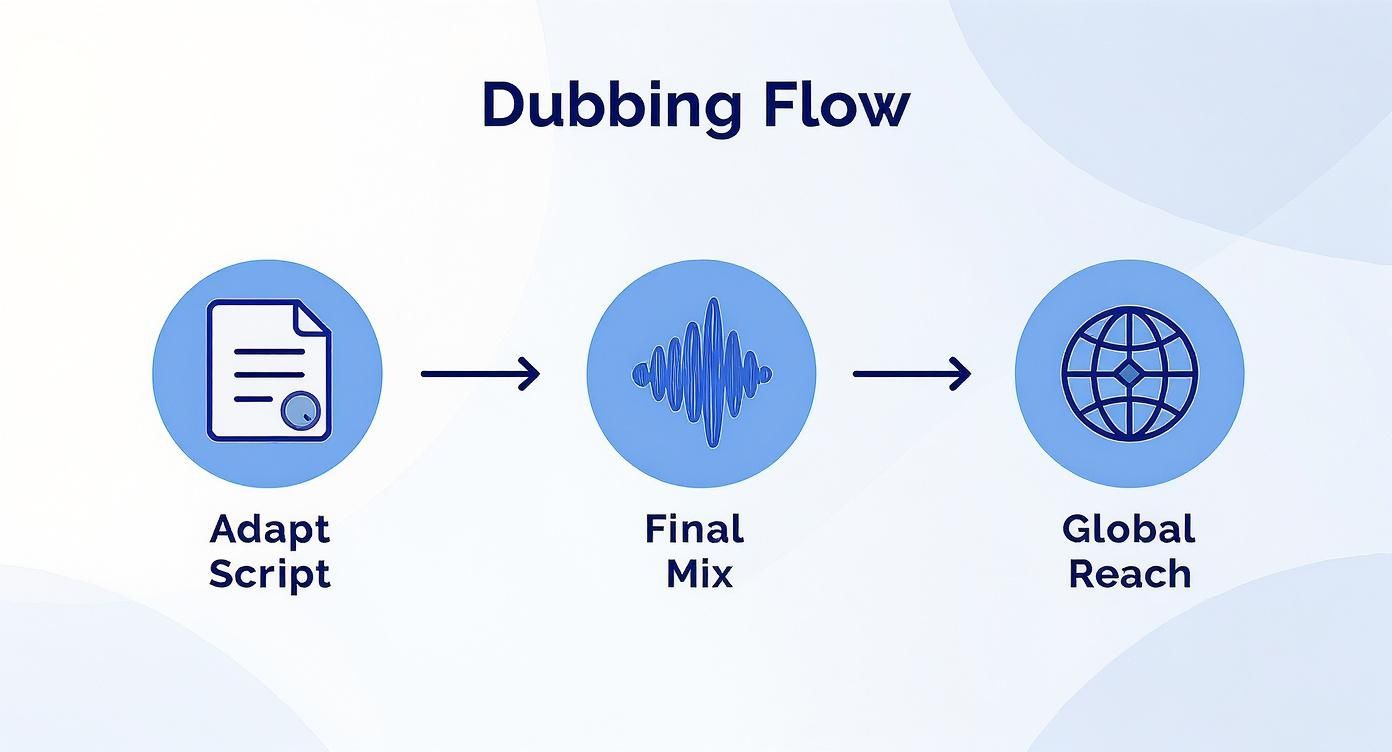
As you can see, getting the script right from the start is what makes a successful final mix possible when you're trying to reach a global audience.
Assemble Your Core Dubbing Assets
Okay, so you've got your M&E track and your newly adapted script. It's time to pull together the final pre-production package. Before getting too deep in the weeds, just remember that dubbing is exclusively for pre-recorded content. It’s worth taking a moment to understand the fundamental choice between live and pre-recorded video if you’re unsure.
Once you’re set, here’s what your final checklist should look like:
- The Final Video File: Get your hands on a high-resolution version of the video you’re dubbing.
- The M&E Track: That clean audio master we talked about, with all original dialogue gone.
- The Time-Coded Script: This is your adapted script, but with timestamps marking exactly when each line should start and end.
- A Pronunciation Guide: Don't forget this! It's a simple list of brand names, technical jargon, or tricky proper nouns with phonetic spellings to keep everything consistent.
A well-organized pre-production package is the single most important factor for an efficient dubbing process. It provides absolute clarity for your voice talent—whether human or AI—and eliminates guesswork during the critical recording and syncing stages.
Success in dubbing depends almost entirely on the quality of the assets you prepare beforehand. By getting all these elements meticulously organized, you’re paving the way for a smooth and effective workflow from start to finish.
Choosing Your Dubbing Method: Human vs. AI
Once you have all your pre-production ducks in a row, you’ll hit a major fork in the road: do you stick with the classic artistry of human voice actors, or do you embrace the incredible speed and scale of artificial intelligence?
This isn't a minor decision. It will fundamentally shape your project's budget, timeline, and even the final emotional connection it makes with your new audience.
The Traditional Human Approach
Going the traditional route is all about performance. It’s a very human process that involves casting voice talent who can truly inhabit the original performance, booking studio time, and directing sessions to coax out the perfect delivery.
This method is king when you need to capture delicate emotional nuances, subtle inflections, or perfect comedic timing. For a narrative film or a heavy drama, the skilled interpretation of a human actor is often non-negotiable.
The process usually breaks down like this:
- Casting: Sourcing voice talent whose vocal quality, age, and style are a dead ringer for the on-screen characters.
- Studio Recording: Laying down tracks in a professional, acoustically treated studio to get that pristine audio quality.
- Performance Direction: Having a director on hand to guide the actors, ensuring they match the original tone, pacing, and emotional beats.
While this path delivers exceptional quality, it’s not without its logistical headaches. Juggling schedules, managing studio bookings, and directing multiple actors across different languages can get complicated—and expensive—fast.
The Rise of AI Dubbing
What was once a sci-fi concept is now a very real, practical tool for creators. The AI dubbing market isn't just growing; it's exploding.
Valued at roughly USD 31.5 million in 2024, the AI video dubbing market is on a trajectory to hit an incredible USD 397 million by 2032. That staggering growth shows just how much AI is changing the game, making global content localization faster and more accessible than ever.
Modern AI platforms do more than just read a script aloud. The best ones can clone the original speaker's voice, transfer emotional intonations, and even automate lip-syncing with surprisingly natural results.
The real magic of AI is its ability to eliminate friction. What used to be a multi-week saga of casting calls and studio sessions can now be turned around in hours, sometimes even minutes.
This technology is reshaping how brands and creators connect with audiences on a global scale. You can dig deeper into AI's impact on creative campaigns to see just how much is changing.
A Head-to-Head Comparison
Choosing between these two paths can feel abstract. To make it more concrete, here's a side-by-side look at how traditional and AI-powered dubbing stack up against each other.
Traditional Human Dubbing vs AI-Powered Dubbing
| Factor | Traditional Human Dubbing | AI-Powered Dubbing |
|---|---|---|
| Cost | High. You're paying for multiple voice actors, studio rental, a director, and an audio engineer. | Low. Often just a fraction of the traditional cost, typically based on a subscription or per-minute rate. |
| Turnaround Time | Weeks. The entire process—casting, scheduling, recording, and post-production—has to be repeated for each language. | Hours. The AI can process and generate all language tracks simultaneously, slashing delivery time. |
| Scalability | Limited. Adding more languages means starting the entire costly and lengthy process from scratch each time. | Highly Scalable. Adding ten more languages is nearly as straightforward as adding one. |
| Consistency | Variable. Different voice actors may bring their own interpretations, leading to tonal shifts across languages. | High. The AI maintains a consistent vocal tone and style based on the source audio for every language. |
| Emotional Nuance | Superior. Human actors are masters of conveying subtle emotions and complex performances. This is their strength. | Good and improving. Best suited for direct, informative content like training videos, news, or e-learning. |
Let’s apply this to a real-world scenario: dubbing a 10-minute corporate training video into three new languages—Spanish, French, and German.
For this kind of project, the choice is pretty clear. AI offers a fast, cost-effective, and scalable solution that delivers the necessary quality for informational content. While a human actor might capture a bit more subtle nuance, the overwhelming practical benefits of AI—speed, cost savings, and consistency across all three languages—make it the smarter business decision.
Recording and Syncing Your New Audio Track
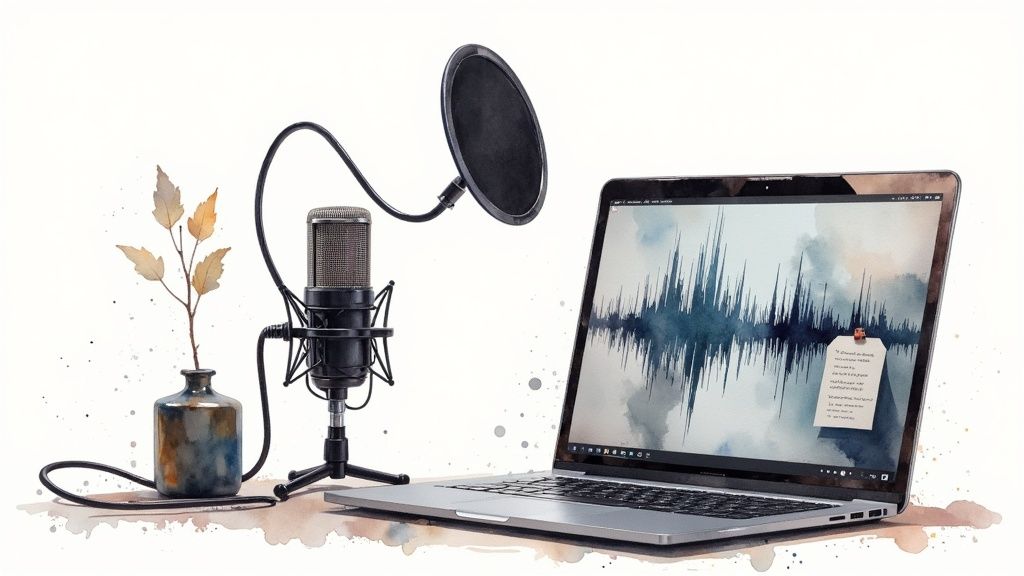
Okay, you've got your adapted script and your M&E track is prepped. Now it's time to get hands-on and bring the new dialogue to life. This is the part where we capture the new performance and carefully weave it into the on-screen visuals.
Frankly, the quality of your work right here will make or break the final product. A believable dub hinges on clean audio and tight synchronization. It doesn't matter if you're working with a human voice actor or an AI platform like Aeon; the end goals are identical. You need crystal-clear audio that feels like it belongs in the scene.
Capturing High-Quality Audio
You really don't need a million-dollar studio to get pro-level sound. What you do need is control over your recording space. Poor audio is the fastest way to scream "amateur dub" to your audience, and the biggest culprits are almost always echo and background noise.
The good news? You can get a massive improvement with just a few simple tricks. Your main goal is to create a "dead" space where sound doesn't bounce around.
Here are a few tips I've picked up over the years:
- Pick the Right Mic: For most projects, a USB condenser microphone is the perfect starting point. They're affordable and capture vocal richness so much better than your laptop's built-in mic.
- Treat Your Space: No, you don't need to buy expensive foam panels. A closet full of clothes is a fantastic makeshift vocal booth. All that soft fabric just soaks up the sound waves and kills that awful echo. Even just hanging some heavy blankets around your desk makes a world of difference.
- Set Your Levels: Do a quick test recording before you dive in. Speak at a normal, conversational volume and watch your levels. You want to adjust the input so you're peaking somewhere around -6dB to -12dB. This gives you enough headroom to avoid "clipping" or digital distortion—something you absolutely cannot fix in post.
A clean recording is the bedrock of a professional dub. No amount of post-production magic can fully rescue audio that was recorded poorly from the start. Taking an extra 15 minutes to set up your space correctly will save you hours of frustration.
Nailing this step ensures your new dialogue has the clarity it needs to blend seamlessly with the music and effects.
The Art of Audio Synchronization
With your pristine audio in hand, the next challenge is getting it perfectly synced to the video. This is where the real precision work begins. You're aiming to align the new dialogue so flawlessly that it feels like it’s coming directly from the person on screen.
There are really two ways to go about this, and the one you choose depends entirely on your content.
Lip-Sync vs. UN-Style Dubbing
Knowing the difference here is crucial for getting the right feel for your project.
| Dubbing Style | Description | Best For |
|---|---|---|
| Precise Lip-Sync | The new audio is timed to match the speaker's exact lip movements. | Narrative films, scripted TV shows—anything where realism is the main goal. |
| UN-Style (Voice-over) | The new audio starts a second or two after the original speaker, with the original just barely audible underneath. | Documentaries, interviews, and corporate training where getting the information across is more important than a perfect performance match. |
For most marketing videos, e-learning content, and brand films, you're going to want a precise lip-sync. It just looks and feels far more professional.
This is where you'll want to be working inside a Digital Audio Workstation (DAW) or a video editor with solid audio tools. You’ll be visually lining up the audio waveforms of your new dialogue with the action on screen. A good trick is to look for the start of a word in the waveform and drag it until it matches the exact moment the speaker's mouth starts to form that sound. It's a painstaking process of nudging clips back and forth by milliseconds until it just feels right.
Here's a pro-tip for scenes with fast-paced dialogue: don't be afraid to slice up a single sentence into smaller chunks. It's often much easier to sync a few words at a time than trying to get one long audio clip to line up perfectly. This gives you much more control over the timing.
Mixing and Mastering for a Professional Finish
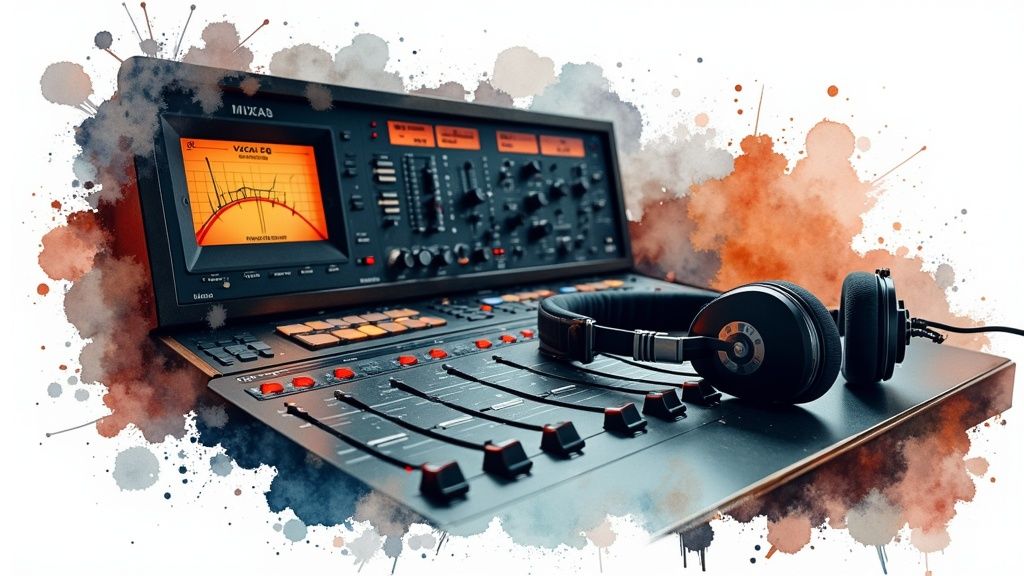
You’ve recorded the new dialogue and meticulously synced it to the video. That’s a huge milestone, but the job isn't quite over. Now comes the final polish: mixing and mastering. This is what separates a functional dub from a truly professional, immersive experience.
This is where you expertly blend your new voice track with the existing music and sound effects, making it feel like it was always part of the original scene. If you skip this, the audio will sound "pasted on," which is an instant immersion-breaker for the viewer. It's your last chance to deliver a project that sounds incredible.
Balancing the Elements in the Mix
The first real task here is mixing. Picture yourself as a conductor with your audio tracks as the orchestra. You’ve got the new dialogue, the background music, and all those sound effects from your M&E track. The goal is to get them all playing together in perfect harmony, with the dialogue clearly taking center stage.
Start by making the dubbed dialogue your primary focus. You'll need to adjust the volume of the M&E track so it sits comfortably underneath the voice. For instance, if you have a loud action sequence, you might need to subtly lower the effects right when someone speaks to ensure their words cut through. This technique, known as "ducking," is a cornerstone of great audio mixing.
The core principle of a good mix is clarity. If your audience has to strain to hear the dialogue over the music or sound effects, the entire dubbing effort is compromised. Your primary job is to guide the listener's ear to the most important element at any given moment—the voice.
Getting this balance right ensures your carefully adapted script is not only heard but felt, without being drowned out by everything else happening in the video.
Using EQ and Compression for Vocal Clarity
Once your basic volume levels feel good, it's time to refine the dialogue track itself. This is where two of the most powerful tools in your arsenal come in: equalization (EQ) and compression.
Equalization (EQ) is all about sculpting the tonal quality of the voice.
- Does the recording sound a bit muffled? A slight boost in the higher frequencies (around 2-5 kHz) can add crispness and intelligibility.
- Is it too boomy or bass-heavy? A gentle cut in the lower frequencies (around 100-200 Hz) can clean that right up.
The goal isn't to make the voice sound unnatural, but to help it sit perfectly in the mix.
Compression, on the other hand, is about managing the volume dynamics. It automatically turns down the loudest parts of the dialogue and brings up the quietest parts. This creates a much more consistent vocal track that's easier for the listener to follow. No more reaching for the volume remote during a scene that jumps from a whisper to a shout.
Adding Reverb to Create a Sense of Space
One final mixing trick is to use a touch of reverb. Reverb simulates the sound of a physical space. By adding just a tiny amount to your dialogue track, you can make it feel like the actor is actually in the on-screen environment, whether that's a small office or a vast, echoing cathedral.
The key here is subtlety. Too much reverb and your actor sounds like they're in a cave. Just enough, and the new audio blends seamlessly into the scene, completing the illusion that it was all recorded on set.
Mastering Your Final Audio Track
With your mix sounding perfect, the very last step is mastering. Think of this as the final quality control check where you optimize the overall loudness and dynamics of the entire audio track for its final destination.
Platforms like YouTube, Spotify, and other streaming services all have their own specific loudness standards. Mastering ensures your video's audio will sound great everywhere—not too quiet, not distortedly loud. It’s a crucial step for delivering a professional and consistent listening experience for every single viewer.
The value of this professional sound work is reflected across the industry. The global dubbing market was valued at USD 4.2 billion in 2024 and is projected to hit USD 8.6 billion by 2034. And in 2024, human-based services still held a massive 58.2% share, showing just how much value is placed on authentic performances backed by expert sound engineering. You can dig into more details in the full dubbing and voice-over market analysis on market.us.
Here are some of the most common questions that pop up when you're getting ready to dub a video. Moving from theory to practice can feel like a big leap, but sorting through these typical hurdles is a lot easier once you have some clear answers.
This section tackles the big ones creators face—from figuring out a realistic budget to handling the technical side of things—so you can get your project started with confidence.
How Do I Budget for a Dubbing Project?
Budgeting for dubbing is definitely not a one-size-fits-all deal. The cost really hinges on your approach and how big the project is. You could be looking at a few dollars a minute for a straightforward AI dub, or you could be spending thousands on a full-blown production with professional voice actors and studio time.
To nail down a realistic number, you’ve got to think about a few key things:
- Video Length: This is your biggest cost driver. Almost every service, whether it's human-powered or AI, is going to charge you by the minute.
- Number of Languages: Each new language is basically a cost multiplier. An AI platform might cut you a deal for bulk work, but going the traditional route means hiring a whole new team for every single language.
- Talent and Production Quality: Are you hiring a seasoned pro or using an AI voice? Are you booking a professional recording studio or doing it from your home office? Every one of these choices will make a real difference to the final bill.
Just to give you a ballpark, dubbing a 10-minute video with a human voice actor, factoring in studio time and mixing, could easily set you back $500 to $2,000+ for each language. On the other hand, using an AI platform for that same video might only cost $20 to $100, which makes it a much more realistic option for creators trying to expand their reach without breaking the bank.
Should I DIY or Hire a Professional?
Deciding whether to dub a project yourself or bring in an expert really boils down to a trade-off between your time, money, and the quality you're aiming for.
Going the DIY route gives you total creative control and can be incredibly light on the wallet, especially with easy-to-use AI tools. This is a fantastic path for internal training videos, quick social media content, or any project where the budget is tight.
But, when the stakes are high, hiring a professional dubbing studio or a freelance engineer brings an expertise that’s hard to replicate. They take care of everything—casting, directing, the final technical mix—to make sure you get a polished, broadcast-ready result. This is usually the right call for narrative films, big marketing campaigns, or any content where nailing a subtle emotional performance is absolutely critical.
My advice? Start with a small test run. Try dubbing a one-minute clip yourself using a tool like Aeon. It'll give you a real feel for the workflow and help you figure out if you actually have the time and skills to tackle the whole project on your own.
What Video and Audio Formats Are Best?
Wrangling file formats can feel like a chore, but getting it right from the start will save you from a world of conversion headaches and quality loss down the line.
For video, MP4 with an H.264 codec is the gold standard. It hits that sweet spot of great quality and manageable file size, and it plays nice with pretty much every platform and editing software out there.
When it comes to audio, you want to stick with uncompressed formats for as long as you can to keep the quality pristine.
- WAV: This is what the pros use for recording and mixing. It's a lossless format, which means it holds onto every bit of the original audio data without any compression.
- MP3 (High Bitrate): While MP3s are compressed, a high-bitrate file (think 320 kbps) is totally fine for the final delivered product. Just make sure you always record and edit in WAV to avoid chipping away at the audio quality.
Always, always ask for the highest quality source files you can get your hands on. Starting with a crisp, clean foundation just makes every other step of the dubbing process that much smoother and leads to a far more professional final video.
Ready to create stunning, dubbed videos at scale without the complexity? Aeon uses powerful AI to transform your content into engaging videos for any audience, in any language. Streamline your production and unlock global reach today. Explore what you can build with Aeon.
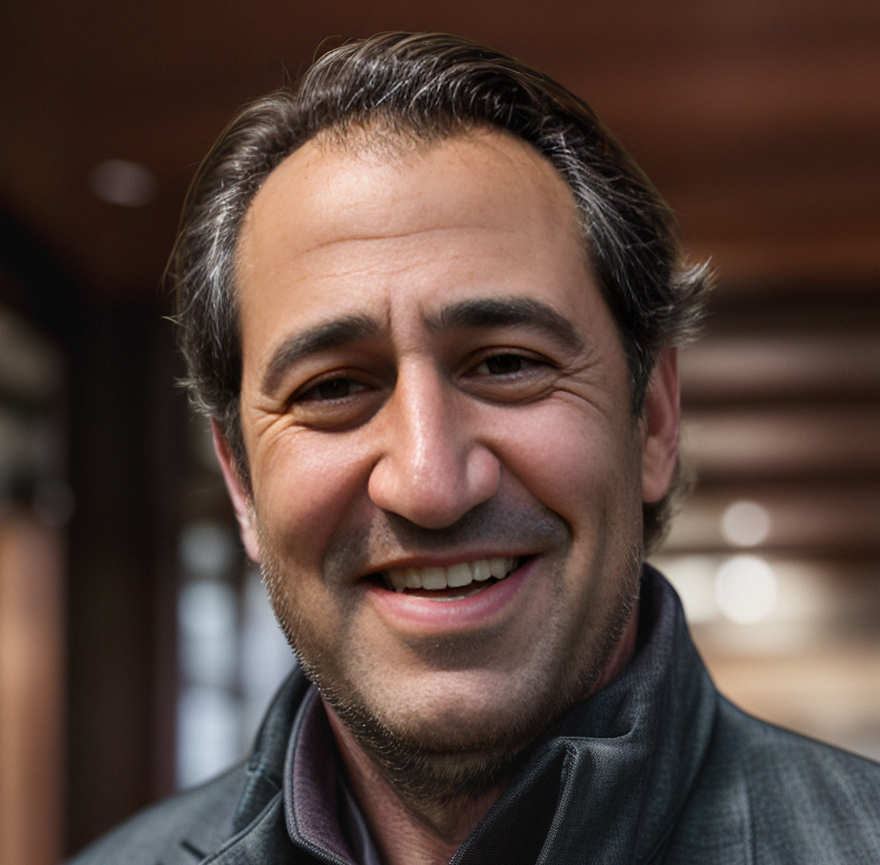
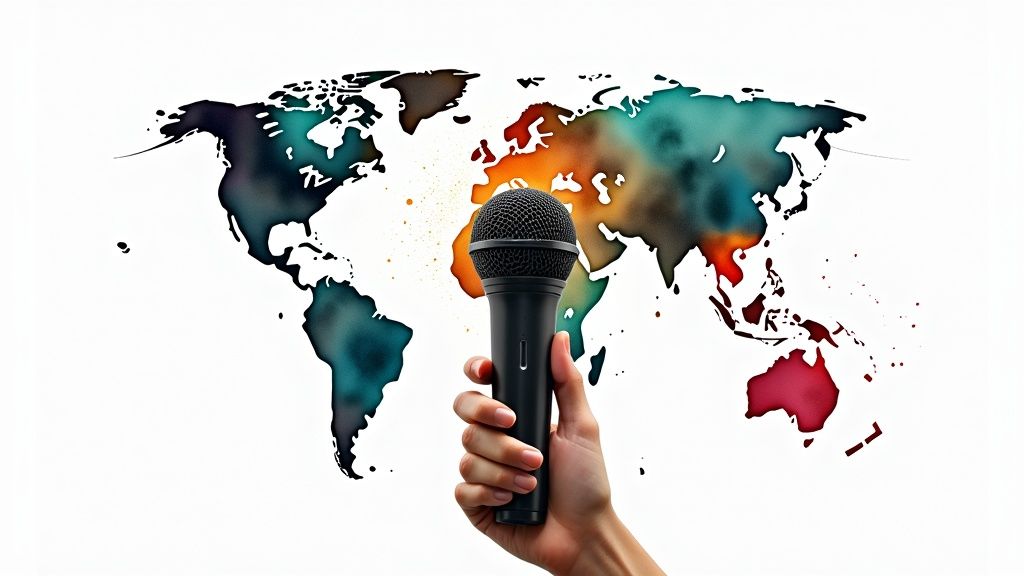
.jpg)